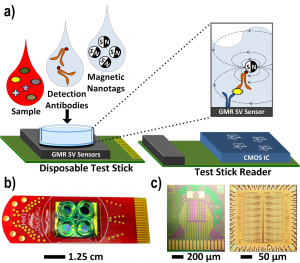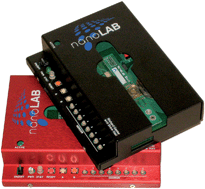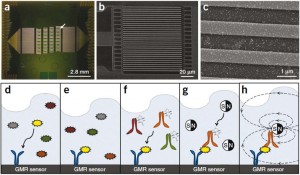A High-Density Magnetoresistive Biosensor Microarray for Quantitative Proteomics

We designed a highly integrated sensor interface and data acquisition system in a 0.18 µm CMOS process to interface an array of 256 giant magnetoresistive (GMR) spin-valve biosensors. The chip from this project has an input-referred noise PSD of 50 nT/√Hz and achieved protein detection 100 times lower than previously reported. Furthermore, it also demonstrated an ultra-compact design for a sigma-delta modulator consuming only 0.05 mm2.
A Highly Sensitive Giant Magnetoresistive Biosensor Integrated into a Continuous Time Sigma Delta Modulator
A GMR spin-valve biosensor is a resistive element inside a continuous-time sigma-delta modulator. This idea was further extended to include frequency domain multiplexing and carrier suppression techniques to improve the readout time and reduce the dynamic range requirements, respectively.
A Computationally Efficient Giant Magnetoresistive Biosensor Interface for Point-of-Care Applications
Supervised and mentored a first-year master’s student in designing a giant magnetoresistive biosensor interface that requires very little digital signal processing. All signal demodulation and filtering are performed in the analog domain creating a sensor interface that is very simple to interface with a simple microprocessor.
nanoLAB

We designed a point-of-care testing device to rapidly detect HIV and Hepatitis-C in developing countries. We miniaturized a research-grade biostation into a handheld, ultraportable device. Also, we re-engineered the bioassay to make it extremely easy to use and wash-free.
Giant Magnetoresistive Biostation

Designed sensor interface and wrote LabVIEW software for several research-grade biostations. This sensor interface and acquisition system was used in several of our research group’s key publications.